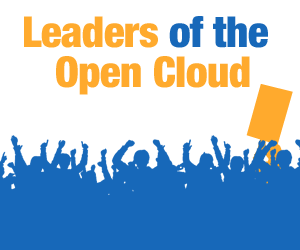As the Senior Director of Cloud Computing Community at Citrix, Mark Hinkle oversees Citrix efforts around the open source Apache CloudStack IaaS platform and Xen hypervisor projects.
Citrix is still very closely involved in CloudStack, which was donated to the Apache Software Foundation in April. Citrix developers are now involved in driving user adoption for CloudStack and helping to shepherd the project through the Apache Foundation’s incubation process.
 “It was a huge change for the project to move from a company-sponsored open source project to a community-run Apache project,” Hinkle said.
“It was a huge change for the project to move from a company-sponsored open source project to a community-run Apache project,” Hinkle said.
But the project has seen more community contributions in the last 90 days than it did in the last two years it’s been open source, he said. CloudStack has also seen a nice uptick in adoption from a wide range of companies that includes cloud hosting providers, social gaming companies and research labs, among others.
“We see hundreds of clouds coming online every month and a lot of feedback and contributions from the user and development communities,” Hinkle said.
In the short term, though, Hinkle’s big project is preparing for the Xen Summit developer meetup, he said, which will run Aug. 27-28, before CloudOpen and LinuxCon North America in San Diego Aug. 29-31. Hinkle will also present a keynote on “The Cloud in 20 Years,” at CloudOpen. We talked recently about the company’s involvement in the open source cloud and how it might model Linux.
How do you define an open cloud?
Hinkle: It’s first and foremost that the orchestration platform is open source. The data you store within the cloud is open to you as the end user in a format you can manipulate easily and it’s easily transferable. The API is also open and clearly documented.
What are the barriers to accomplishing an open cloud?
Hinkle: When service providers implement in a way that’s easier to upload data but harder to move large blocks of data, that makes it tough for the cloud to be easily portable.
The other thing is governance. You want to look at projects with a governance model led by an impartial community keeping everybody’s interests in mind.
How do CloudStack and OpenStack differ?
Hinkle: OpenStack is a collection of about 17 different projects; some are even complimentary to CloudStack, like OpenStack Storage (Swift) or Dell’s Crowbar. But what makes us unique is probably the self-service portal and the ability to easily delegate the creation of infrastructure to people within your organization as well as the ability to offer network services packaged with service offerings.
It’s also been in production commercially for a couple of years so it’s very mature and stable. Citrix has a lot of public customers that have been running CloudStack clouds for well over a year.
I’ve read about concerns recently that too many open source projects competing against proprietary clouds fragments the effort to create a competitive open source alternative. What’s your view on this issue?
Hinkle: That’s crazy talk. In a single vendor-led market the products become mediocre and the expense to the end user becomes high. Especially in a market as large as cloud computing where there’s plenty of room for multiple players, the only time fragmentation is a bad thing is when there’s an incumbent single vendor that owns a majority of the market.
The key is open standards, open APIs, so clouds can be federated and guest infrastructure can be portable. Consolidation and too much standardization doesn’t make much sense if you want innovation and high quality.
Do you have advice for IT professionals considering a move to the cloud?
Hinkle: Think through what the end use requirements are and the level of utility. Do they need highly available storage, computing or disaster recovery, for example, before they start building their cloud? That should be a design point early on.
They should also understand the level of data integrity and backup they need. A lot of people have an ephemeral architecture and data doesn’t need to be archived long-term.
A lot of people are just using cloud as a greenfield. For example, their existing infrastructure may have SAP or other financial data on it and they have to have highly available data but their new project may be images for short-term projects –groups they bring on for a few weeks and then shut down.
Sometimes we call that the Amazon model where you’re going to keep your costs low for temporary projects. Then there’s the legacy model from VMware where you build highly redundant datacenters. In our experience the new greenfield opportunities are more Amazon-like and migrations are more VMware like.
What do you plan to discuss in your keynote at CloudOpen?
 Hinkle: I wanted to look at the 20 years of Linux and apply the lessons we learned there so we have the same degree of success with the cloud that we did with open source Linux.
Hinkle: I wanted to look at the 20 years of Linux and apply the lessons we learned there so we have the same degree of success with the cloud that we did with open source Linux.
There are multiple vendors that offer Linux distributions through the years and continue to. They may have used the same underlying kernel but they always adhered to open source and open standards. Adhering to the Linux standards base made it a widely deployed operating system that gives you a great amount of choice.
One of the big lessons we learned from Linux was that while every distro wanted to be the best, at the end of the day we all worked from a common code base that made Linux what it is. At the point where we don’t collaborate at least at some level, we’re not going to see the success that Linux had in the open cloud. We don’t want the competition to be among open source cloud platforms. The issue is proprietary systems that don’t believe in open source and don’t serve the best needs of their customers.
How does the industry go about creating standards?
Hinkle: I don’t know that you cause standards to happen as much as they evolve. The only standard everybody acknowledges is the open virtualization format driven by a small group of vendors and championed by the DMTF (Distributed Management Task Force).
What’s happening now in the cloud is the evolving standard is the Amazon API because they are the leader. If you wanted to be a private cloud vendor you want to keep compatibility that way. Sometimes de facto standards just arrive and everybody accepts them because they make sense and cause less strife for users.
I think the next one will be in the platform space, PaaS. How can payloads be deployed from (VMware’s) CloudFoundry to Red Hat’s OpenShift to others? How that happens remains to be seen.


